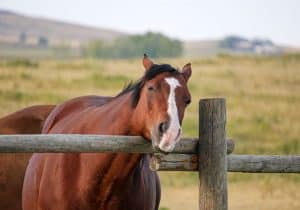Equine Bandaging Do’s and Don’ts
- Topics: Article, Bandaging, First Aid & Emergency Care, Horse Care, Lower Limb

Tips and tricks for managing fresh wounds and swollen limbs properly
Every horse owner has been there: You walk out to the pasture to catch your horse, you peek into his stall, or maybe you open the trailer door upon arrival and see it immediately—a fresh wound, a swollen leg, or other evidence your horse has injured himself.
As you begin to investigate the injured area more closely, you might wonder if it requires a protective bandage. You might also wonder whether it’s serious enough to call your veterinarian.
Here, we’ll give you a few tips when it comes to bandaging your horse. Of course, you should call for professional assistance in any kind of emergency, but this overview will prepare you for when your vet says it’s time to apply or replace a wrap, or when you simply want to protect and support the legs of an uninjured horse.
When Should You Use a Bandage?

Not every situation requires a bandage, and bandaging can cause more harm than good in some cases. In general, bandages or wraps are useful for:
- Keeping a wound clean and contamination-free.
- Reducing swelling.
- Providing support and offering protection from trauma during training, transport, or turnout.
- Promoting a healing environment.
- Stabilizing an area.
- Triaging hemorrhage.
Before you find yourself in this situation, familiarize yourself with the materials required to bandage a horse properly.
Bandaging Materials
The materials you use to bandage your horse vary based on the wrap’s purpose. Bandages that cover a wound typically include three layers: gauze and gauze bandage, following by cotton roll or quilt, then standing wrap, cohesive bandage (Vetrap or CoFlex), or porous elastic adhesive cloth tape (Elastikon).
If you’re wrapping your horse’s legs for support, protection, and/or to reduce swelling during stabling or transport, you’ll likely use a standing wrap. For training, you might consider polo wraps (see sidebar on page 12) Current magazine subscribers can click here to and continue reading. We at The Horse work to provide you with the latest and most reliable news and information on equine health, care, management, and welfare through our magazine and TheHorse.com. Our explanatory journalism provides an understandable resource on important and sometimes complex health issues. Your subscription will help The Horse continue to offer this vital resource to horse owners of all breeds, disciplines, and experience levels.This story requires a subscription to The Horse magazine.
Subscribe now and gain unlimited access to premium content.
Subscribe Now
Written by:
Emily Dickson, MS
Related Articles
Stay on top of the most recent Horse Health news with















